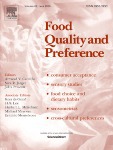Can children use temporal sensory methods to describe visual and food stimuli?
Dublin Core
Título
Tema
Abstract
objective of the study was to evaluate the feasibility of using two dynamic methods (temporal check-all-thatapply -TCATA- and Temporal dominance of sensations -TDS-) for sensory characterization with children. A video
featuring colored circles (varying in size, appearing and disappearing) was used to convey the idea of temporal perception and to familiarize children with the methods. A series of six vanilla milk desserts was used in the tasting session. A total of 102 children (8 to 12 years old) recruited from two Uruguayan schools participated in
the study. They were randomly divided in two groups, each of which used one of the methods. Results showed that TCATA and TDS allowed capturing the dynamics in the video. However, TCATA provided a more detailed
description of how the colored circles evolved with time than TDS. In the case of the milk desserts samples, both methodologies showed similar results regarding the most relevant sensory characteristics. However, children
mostly used them as static methods. In the TDS task, children dithered for long before selecting a new attribute, which points towards difficulties in evaluating dominance. Results from the present work suggest that refinements are needed to make TCATA and TDS methods applicable with children for characterizing food stimuli.
Autor
Fuente
Editor
Fecha
Derechos
Información sobre Derechos de Autor (Por favor lea este aviso antes de abrir los documentos u objetos) La legislación uruguaya protege el derecho de autor sobre toda creación literaria, científica o artística, tanto en lo que tiene que ver con sus derechos morales, como en lo referente a los derechos patrimoniales con sujeción a lo establecido por el derecho común y las siguientes leyes (LEY 9.739 DE 17 DE DICIEMBRE DE 1937 SOBRE PROPIEDAD LITERARIA Y ARTISTICA CON LAS MODIFICACIONES INTRODUCIDAS POR LA LEY DE DERECHO DE AUTOR Y DERECHOS CONEXOS No. 17.616 DE 10 DE ENERO DE 2003, LEY 17.805 DE 26 DE AGOSTO DE 2004, LEY 18.046 DE 24 DE OCTUBRE DE 2006 LEY 18.046 DE 24 DE OCTUBRE DE 2006) ADVERTENCIA - La consulta de este documento queda condicionada a la aceptación de las siguientes condiciones de uso: Este documento es únicamente para usos privados enmarcados en actividades de investigación y docencia. No se autoriza su reproducción con fines de lucro. Esta reserva de derechos afecta tanto los datos del documento como a sus contenidos. En la utilización o cita de partes debe indicarse el nombre de la persona autora.
Formato
Idioma
Tipo
Identificador
Document Item Type Metadata
Original Format
- Fecha de agregación
- September 18, 2020
- Colección
- Bibliografía Nacional Química
- Tipo de Elemento
- Document
- Etiquetas
- Alimentos, Evaluación sensorial, Niños, Tcata
- Citación
- Velázquez, Ana Laura, “Can children use temporal sensory methods to describe visual and food stimuli?,” RIQUIM - Repositorio Institucional de la Facultad de Química - UdelaR, accessed July 26, 2024, https://riquim.fq.edu.uy/items/show/6136.
- Archivos

